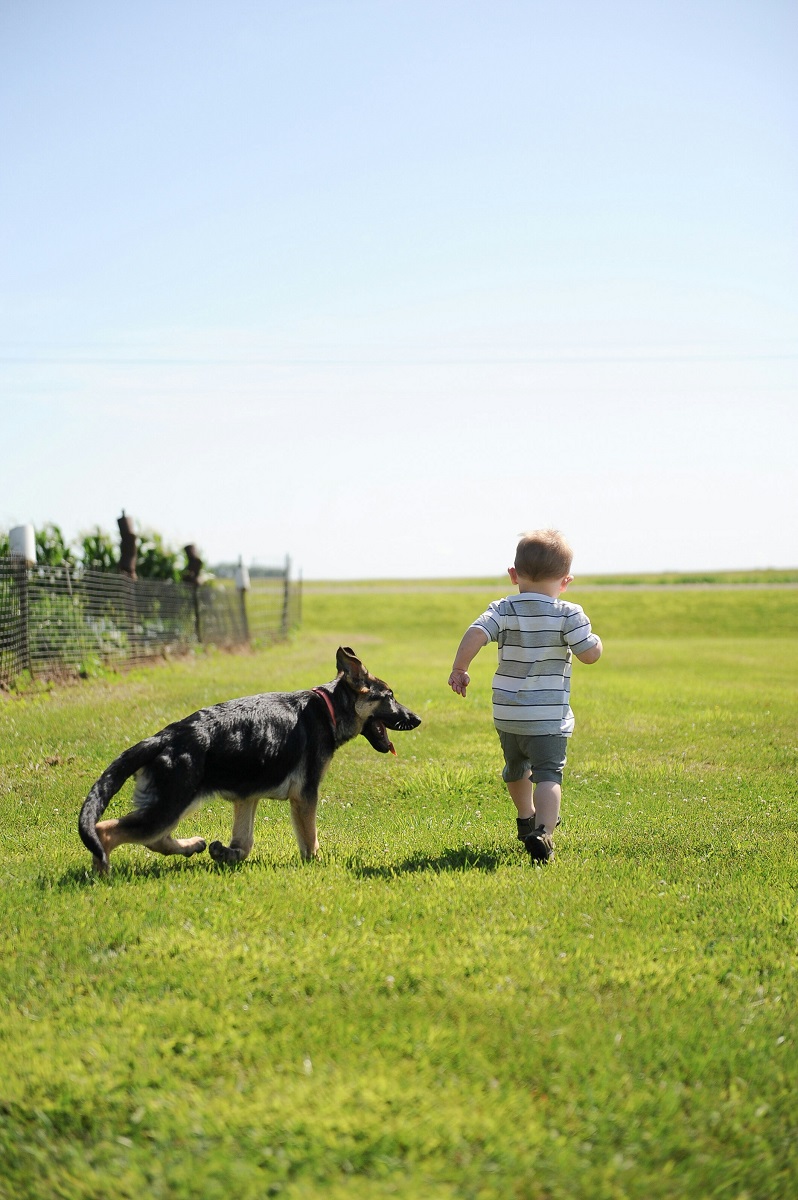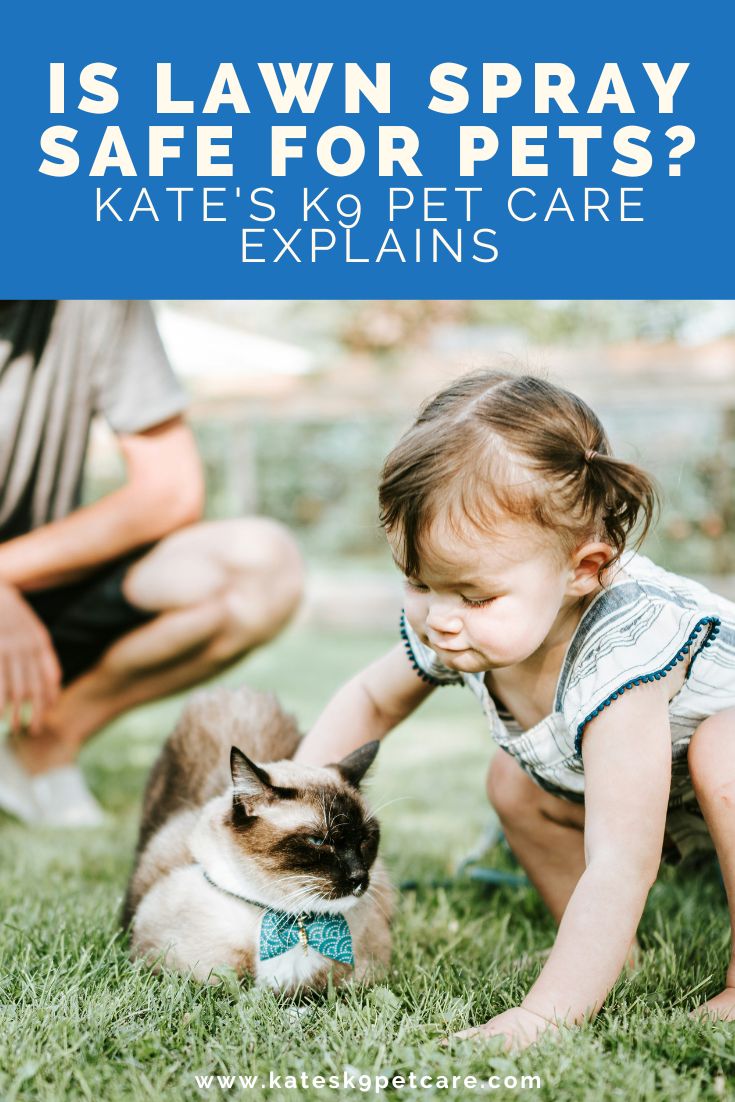Disclaimer: Kate’s K9 Pet Care proudly provides dog walking, cat sitting, small animal pet care, pet taxi services, “Almost Overnight” pet care, and convenient pet supply delivery.
For full details about each of our services, please visit our Service Pages to learn more about how we can support your pet’s needs. To see where we currently operate, please visit our Service Area Page.
Spring season is around the corner, so for folks with a backyard, it’s about time to start getting the lawn in good shape after its winter slowdown. For many of us, this means the use of chemical sprays to get rid of pesky weeds and common pests. But what if you have dogs, cats, or other pets with yard access? Is lawn spray safe for pets, or should you be taking special measures to keep your furry friends safe?
Before spraying your lawn, it’s important to be aware of the possible risks. Find out everything you need to know about pet-safe lawn care below!
What do lawn sprays contain?
The unfortunate answer to “is lawn spray safe for pets?” is: it depends. There are as many different types of lawn sprays out there as there are potential issues to be had with our grassy areas—quite a few! While most people mainly spray their lawn in order to get rid of annoying weeds, it’s also common to use pesticides, fungicides, and fertilizers with all sorts of natural and chemical additives.
Need Pet Care Fast?
Submit an Instant Service Request today and we’ll take care of the rest.
Now, even though they’re often marketed as safe, few of us will be surprised to hear that some lawn sprays can in fact be bad for pet (and wildlife, human) health. After all, in order to be able to kill weeds or bugs, they must contain some kind of toxin! Generally speaking, herbicides aren’t as bad as pesticides, but they can still cause health issues if your pet is exposed directly or frequently.
When buying lawn sprays for whatever purpose, keep an eye out for the following compounds (among others). Some of these (like carbamates and pyrethroids) mostly cause acute poisoning, while others (like glyphosate and atrazine) are associated with long-term risks with repeated exposure.
- Glyphosate: its carcinogenic (cancer-causing) effects are the subject of debate, but vets recommend caution because exposure can cause nasty gastrointestinal upset and respiratory issues. Cats seem to be more sensitive to glyphosate than dogs.
- 2,4-D: the carcinogenic effects of this common compound on dogs have been studied (cats not so much, unfortunately); it appears to increase the risk of lymphoma and carcinoma. Ingestion or contact with freshly sprayed 2,4-D can cause serious gastrointestinal issues.
- Dithiopyr: used for preventing crabgrass. It’s not highly toxic, but ingestion can cause mild symptoms in pets.
- Pyrethroids: this insect-killing agent is unfortunately also dangerous to our pets. Exposure can lead to mild symptoms like gastrointestinal distress all the way to seizures and deaths.
- Imidacloprid: used for grub control in lawns, this compound is considered mostly safe for pets, although ingestion of large amount can cause problems. It’s very toxic to insects, though, and might negatively affect your garden by damaging pollinator populations.
- Triclopyr: against broadleaf weeds and woody plants. Has been found somewhat toxic, but can cause gastrointestinal problems.
- Atrazine: for controlling broadleaf and grassy weeds. It has low to moderate toxicity to mammals like cats and dogs, but can be problematic, especially with chronic or repeated exposure.
- Carbamates: another toxic group of insecticides, of which carbaryl (Sevin®) is the most common. It can damage the nervous system, causing neurotoxicity when touched or ingested by pets.
Although they’re not used in spray form, we do also want to touch upon the dangers associated with rat poison (strychnine, bromethalin), as well as mole/gopher bait (zinc phosphide), snail/slug bait (Metaldehyde) and the like. Keep those far, far away from your furry family members! And although they’re not used as commonly, don’t forget fungicides either. Compounds like Thiophanate-methyl and Myclobutanil won’t make your pet drop dead this instant, but we still regard them with suspicion. Direct exposure or repeated ingestion are likely to cause problems.
Did you know? Some lawn sprays marketed as fertilizers or ‘weed & feed’ can also contain herbicides (or high nitrogen levels, which can be irritating to paws and skin). They should definitely be left to dry fully before you let your pet run around where you applied them.
How do pets get exposed to dangerous lawn sprays?
In most cases, even when a lawn spray contains potentially dangerous compounds, harmful exposure can be prevented by using it responsibly. The biggest danger tends to be direct ingestion, which is more of a risk with granulated products and baits than products in spray form. Still, sprays can end up in your pet’s tummy as well, especially if your furry friend makes it out onto the lawn before the spray has dried properly. Both dogs and cats eat grass sometimes, which is exactly where you apply the spray.
Additionally, pets may track lawn sprays inside and swallow it at a later stage: they walk and roll around on the grass, then groom themselves afterward and ingest whatever is on their fur or paws. There are even cases where they drink from garden ponds and puddles, which may contain pesticide or herbicide run-off. Although this exposure may not lead to immediate symptoms as described below, some lawn spray compounds are associated with certain cancers, as well as endocrine (hormonal) disruption, if your pet is exposed on a regular basis.
Exposure to chemicals in lawn sprays can also happen through dermal contact (again, walking and rolling around) and, to a lesser degree, inhalation. The latter is the most dangerous form of exposure, but also the rarest—your pet would have to be present while you’re spraying or get access to freshly sprayed grass that’s still giving off fumes.
If you’ve recently sprayed your lawn and your dog, cat or other pet shows the following symptoms, you should call your vet ASAP and tell them which product(s) you used and when. They’ll tell you if you should bring the patient in:
- Drooling or foaming at the mouth
- Teary eyes or runny nose
- Vomiting or diarrhea
- Muscle tremors or twitching
- Mild loss of coordination, wobbliness
- Fast breathing
- Anxiety, restlessness
- Excessively big or small pupils
If you notice more severe symptoms, don’t wait—drive straight to a vet ER, you can have someone call them to advise while you’re on your way:
- Seizure
- Trouble breathing and/or blue gums
- Unresponsive, unconscious, very weak, or (partially) paralyzed
- Unusual heart rate (slow, arrhythmic)
- Blood in vomit or diarrhea
Tip: If you still have the product or at least the container, you should bring those along to help your veterinarian figure out what’s going on with your pet.

By using lawn spray responsibly, you make sure everyone can safely play on the grass this summer.
How to protect your pets AND your lawn
It can be difficult to strike a balance between keeping our furry family members safe while still maintaining a lovely green lawn. Still, even if you don’t want to give up on using herbicides and pesticides to maintain your garden, it’s possible to greatly reduce any risks. The first step is informing yourself about potentially dangerous compounds and the symptoms of exposure. You just did that, so good job!
The most important measure to take when using lawn sprays is to follow the instructions on the bottle or leaflet. Don’t exceed the recommended dosage, and be sure to keep your pet(s) inside until the product is fully dry. This can be very quick if it’s nice and sunny, but may take up to 48 hours if the weather isn’t cooperating. It may be a good idea to avoid spraying on windy days, as the breeze can carry fumes to areas where your or other people’s pets are present.
Other safety tips include:
- Carefully read the label of any lawn spray you buy, so you can judge whether it’s worth it to you to use it
- Wipe your pet’s paws (and optionally belly, etc.) after it has been outside on treated grass
- Store sprays securely to prevent curious pets from getting into them or chewing on the bottles
Lastly, remember that pet-safe alternatives do exist. If you’d like to treat your lawn but want to avoid any risks, they’re probably the best option. Look out for products with herbicidal soap or acetic acid (vinegar, which can still be irritating to the skin but won’t cause trouble if you let it dry properly) against weeds or diatomaceous earth, cedar oil (avoid direct exposure), predatory nematodes, and neem oil.
And hey, classic weed whacking still exists—it’s a lot more work, but for many people, it’s worth the peace of mind.
Tip: Essential oils are sometimes sold as natural herbicides or pesticides. They are indeed natural, but some can still be harmful to pets like dogs and cats. Always check before using any type of lawn spray!
Conclusion: Is lawn spray safe for pets?
So, is lawn spray safe for pets? Well, as we’ve seen, many herbicides and pesticides contain compounds that are potentially toxic to our furry friends. Some are worse than others, and the danger can usually be contained by using these products as indicated. Still, we think it’s better to be safe than sorry, especially because our pets aren’t the only ones affected: pollinators, local wildlife and the wider environment can also suffer. Pet-safe and eco-friendy alternatives do exist, so we encourage you to consider these.
Sources & further reading








